ARTICLES BEING VIEWED NOW:
- Régine Crespin
- Hector Berlioz
- Ruth Railton
- Marián Varga
- Marina Koshetz
 DISCUSSION: What is a work? John Dante Prevedini leads a discussion about The performing artist as co-creator, including contributions from Halida Dinova, Yekaterina Lebedeva, Béla Hartmann, David Arditti and Stephen Francis Vasta.
DISCUSSION: What is a work? John Dante Prevedini leads a discussion about The performing artist as co-creator, including contributions from Halida Dinova, Yekaterina Lebedeva, Béla Hartmann, David Arditti and Stephen Francis Vasta.
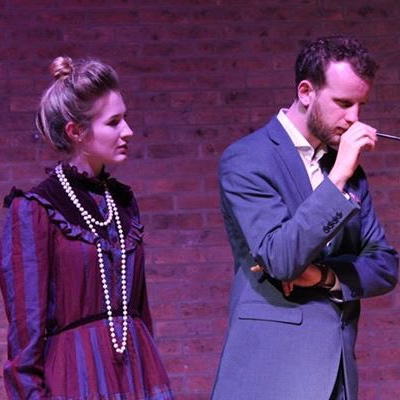 SPONSORED: Ensemble. A Great Start - Freddie Meyers' new opera A Sketch of Slow Time impresses Alice McVeigh.
SPONSORED: Ensemble. A Great Start - Freddie Meyers' new opera A Sketch of Slow Time impresses Alice McVeigh.
All sponsored features >>
Conceived for TV
GIUSEPPE PENNISI experiences Teatro dell'Opera di Roma's 'La bohème'
There is no two without three. On Friday 8 April 2022, the last stage of a film project that saw the light during the pandemic landed on the television screens of Rai3: a new film-opera produced by the Teatro dell'Opera di Roma and Rai Cultura, La bohème by Giacomo Puccini, conducted by Michele Mariotti, musical director of the theatre, and directed by Mario Martone. The two titles that preceded it in 2020-21, Il barbiere di Siviglia (Abbiati Award for the best musical production) and La traviata, both signed by Mario Martone with the musical direction of Daniele Gatti, had an extraordinary success with audience and reviewers. Rome Opera continues in the sign of experimentation, change and creativity, towards a radically innovative opera house language in search of a new audience.
These are not works produced in the studio by Rai as if you were in the theatre and that appeared on the small screen in black and white, as was done in the fifties and sixties of the last century. An attempt of this kind, Adriana Lecouvreur made by the Teatro Comunale di Bologna during the pandemic, has had little success. These are productions designed to be enjoyed on television (with all the opportunities that the medium offers). A similar production was La traviata produced (always during the dark moments of the pandemic) by the Teatro Massimo Bellini in Catania and by the TV Channel Classica HD.
Everyone knows Puccini's La bohème because it is one of the most performed and most loved operas, not only in Europe - I remember magnificent productions in both Paris and Budapest - but all over the world. In Puccini's catalogue, La bohème is a unique opera, with an unmistakable colour. Eclectic, such as to admirably blend melodrama, German romanticism, French opera lyrique and the romance-living room song: it is the most shining Italian example of literaturoper. Also, for this reason, the opera is mindful of Bizet, Massenet and Gounod more than of the Italian tradition.
Last summer Teatro dell'Opera proposed a new production at the end of the summer season at the Circus Maximus - a show that deserved to be seen and heard, but that did not have the level of absolute excellence of the one presented in June 2018 at the Teatro Costanzi, the main headquarters of the Opera House. One of the reasons is, in my opinion, the attempt by Davide Livermore - stage direction, scenes, costumes, lights - to create a production designed for a large outdoor stage, using late nineteenth century French visual projections. La bohème is an intimate work that can be performed in an open-air theatre, but with the syntax and lexicon of an indoor theatre. I remember, at the beginning of the seventies, a wonderful La bohème - Renata Scotto and Franco Corelli were the protagonists - brought from New York Metropolitan Opera to the Wolf Trap near Washington – a very large stage and spectators who, as well as in the stalls and boxes, were in the meadow, where picnics were allowed. A simplified version of the production designed by Franco Zeffirelli for La Scala in 1963 was used. It worked perfectly.
La bohème is always contemporary. It was at the time of Henry Murger who had set it in 'his' Paris of 'his' time (1840-50). When Giacomo Puccini composed it, postcard Paris is, in fact, the Milan of the Years of Scapigliatura (last decade of the nineteenth century). In the last chapter of Murger's Scenes of a Bohemian Life, the novel that inspired both Leoncavallo and Puccini, a year has passed since Mimì's death. Both the poet Rodolfo and the painter Marcello (as well as the musician Colline and the philosopher Schaunard) have made their fortune in their respective professions. They have also become bourgeois. Marcello just spent a night with Musetta – but it was 'a sad night ... it was never the same, not at all!'. 'Youth', concludes the painter with a touch of bitterness, 'has only one season'. The hard core of the work is not the imaginary Paris of 1840-50, but the last phase of youth, that of lightheartedness brought abruptly to an end by the death of Mimì. This is a contemporary theme as never before, especially today in an Italy with high 'intellectual' unemployment and NEET (young people Not in Education, Employment or Training), as can be a poet with journalistic ambitions, a painter, a graduate in philosophy and a novice musician. In 2018 Alex Ollé of Fura dels Baus (and his colleagues Alfons Flores and Lluc Castells) got it right by setting the parable of the end of youth in a suburban Rome low income area.
'La bohème', says Musical Director Mariotti, 'is a work full of death because it is full of life, whose protagonists express joy of living and fear of facing the responsibilities that life presents'. In this television version, the story of the young Parisians of the late nineteenth century is told to us through the eyes by Martone who associates loves, friendships, enthusiasms, anxieties and even sufferings, with a representation of reality immersed in the present. 'I wanted to tell the story', declares Martone, 'or rather, the life of the characters of Bohème as a film of the nouvelle vague: youth, friendship, dreams, rebellion, betrayals, love. And it is incredible how much energy a work written more than one hundred and twenty years ago can still release today'. The colours are reminiscent of Truffaut movies such as La Nuit américaine (Day for Night).
The opera film is shot with live musical footage not playback of a recording. It is set in the Scenography Workshops of the Teatro dell'Opera di Roma. This is a fascinating building of industrial archeology, including workshops for scenographers-painters, immense deposits of costumes and scenic and carpentry equipment, a beautiful terrace on the Circus Maximus and the Aventine. It is the ideal set for the representation of Puccini's youth as well as to see the story from a new point of view: no longer the empty space of the audience of indoor theatres, but the space behind the scenes where the opera is built. Careful acting contributes a lot.
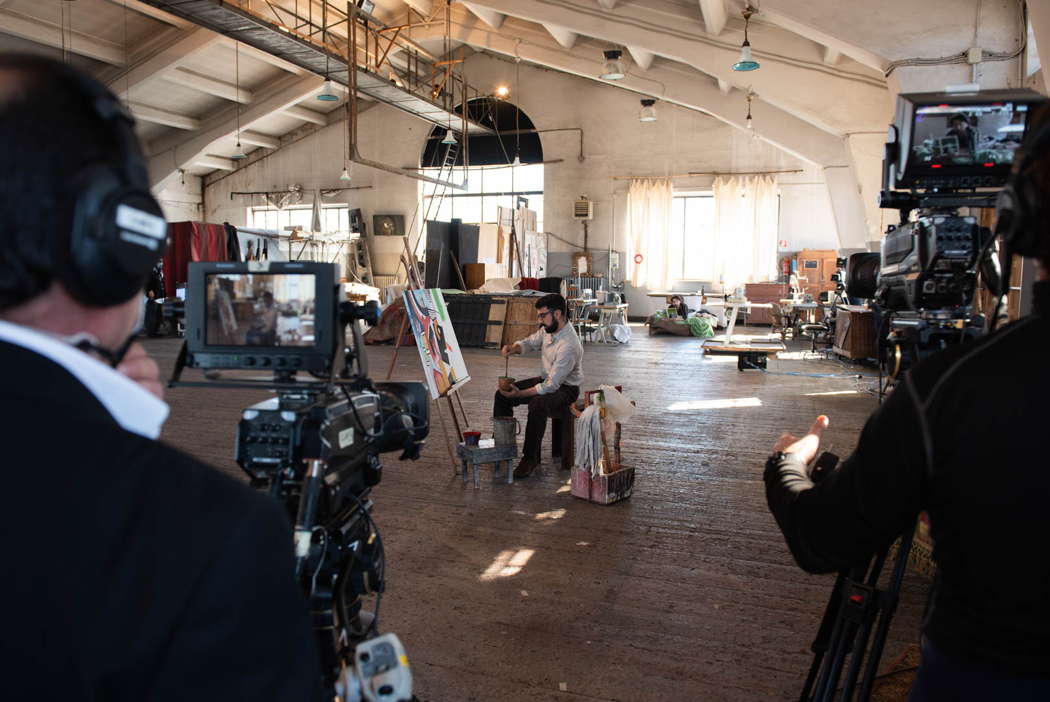
Davide Luciano as Marcello in Teatro dell'Opera di Roma's La bohème. Photo © 2022 Fabrizio Sansoni
The orchestra of the Teatro dell'Opera (which can be counted among one of the best of the Italian opera foundations) is in the immense spaces of the hall, flooded with light, with conducting by Michele Mariotti that fascinates and enchants.
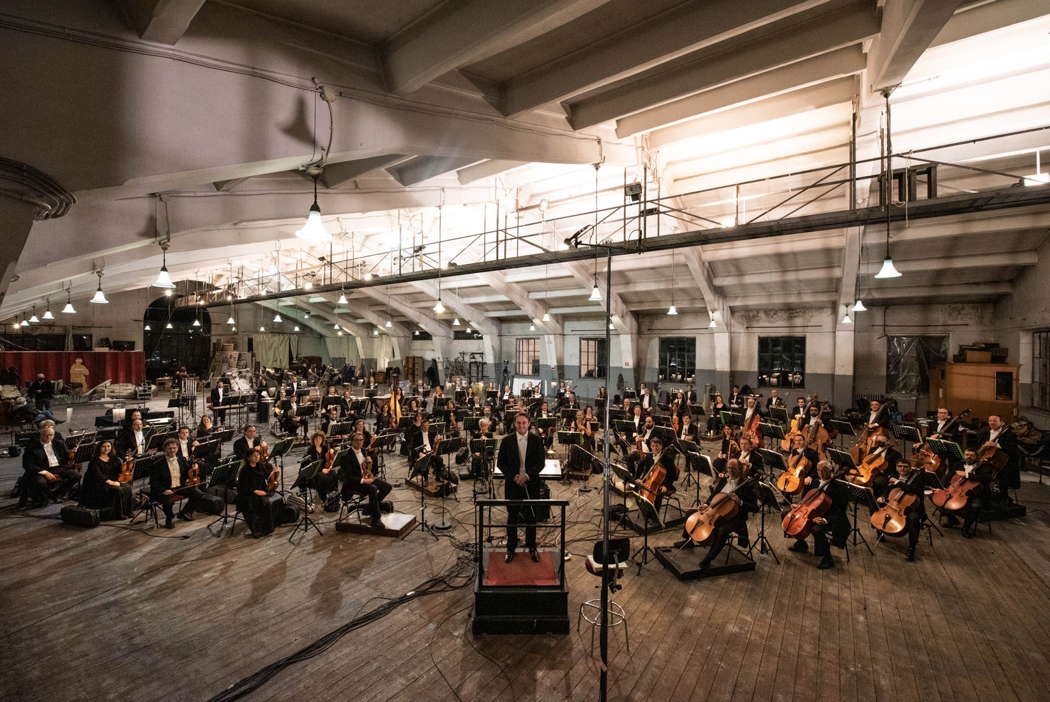
The Orchestra del Teatro dell'Opera di Roma directed by Michele Mariotti for Teatro dell'Opera di Roma's La bohème. Photo © 2022 Fabrizio Sansoni
I must say that I knew Mariotti's Verdi and Rossini (and also Poulenc's Les dialogues des Carmelites) but not his Puccini. Underneath the symphonism that accompanies the four short 'scenes', Mariotti and the orchestra delve into musical motifs that are connected to a symbolic and descriptive meaning, refer to a character, a situation, an object, and a feeling. There are many thematic developments: they give a sense of continuity to the whole opera. However, but unlike Wagner (who developed the motifs in increasingly complicated ways), Puccini resorts to themes that remain more or less unchanged and therefore easy to recognize. The only true case of Wagnerian development is Mimì's motif of the fourth 'scene'. Of course, these subtleties are appreciated if you have a TV with high-fidelity audio.
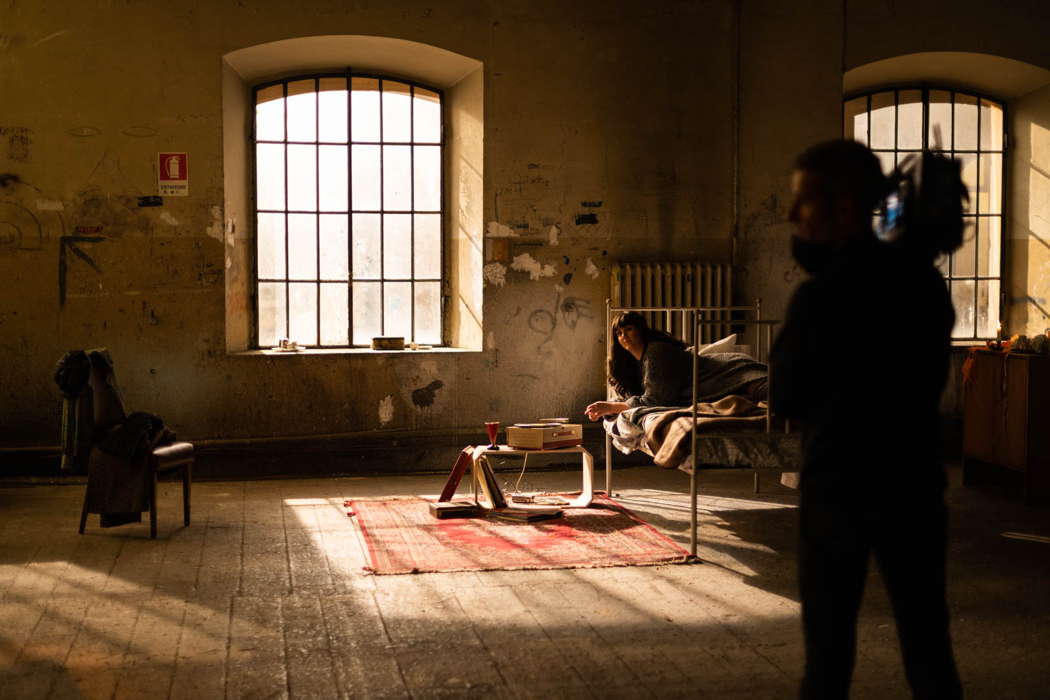
Federica Lombardi as Mimì in Teatro dell'Opera di Roma's La bohème. Photo © 2022 Fabrizio Sansoni
Rodolfo is played by Jonathan Tetelman. Federica Lombardi is in the role of the sweet Mimì. Tetelman is a young tenor (born in 1988 in Chile but raised in the United States) who triumphed in La bohème at the Semperoper in Dresden; he is a generous tenor with a center register, excellent ringing, magnificent legato and beautiful phrasing. Federica Lombardi is known as an 'absolute soprano', excellent in a role like that of Mimì, which requires a lyric soprano in the first two 'scenes' and a dramatic one in the other two.
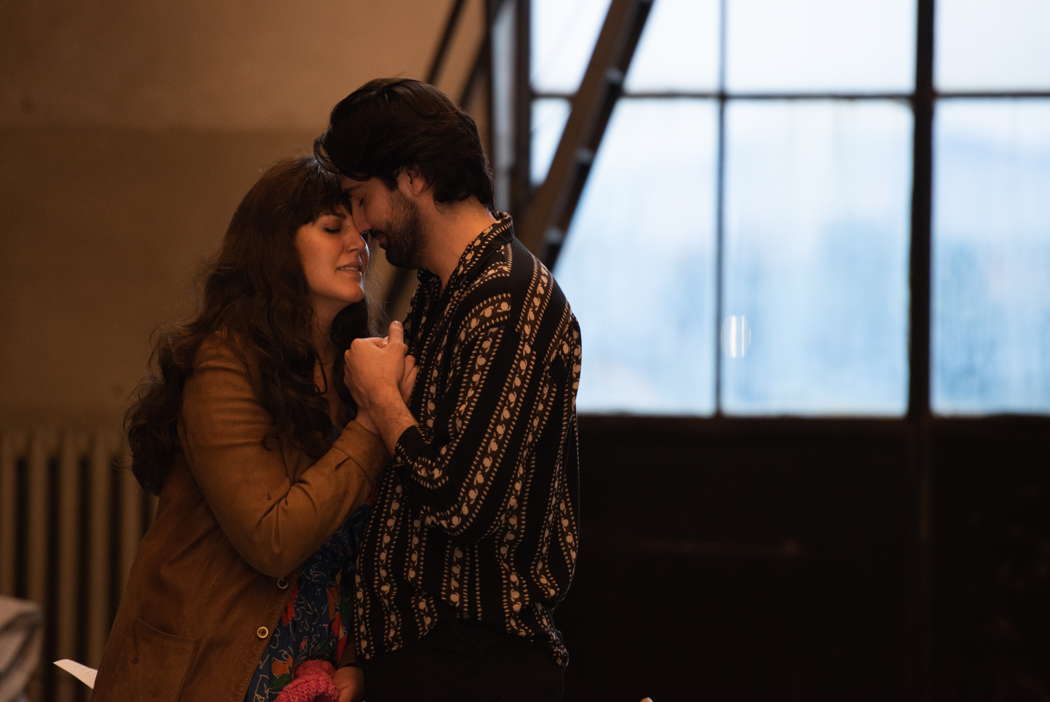
Federica Lombardi as Mimì and Jonathan Tetelman as Rodolfo in Teatro dell'Opera di Roma's La bohème. Photo © 2022 Fabrizio Sansoni
Musetta and Marcello are played by Valentina Naforniţă (born in 1987 in Moldova and best known for Mozart roles) and Davide Luciano (also young but already with an international career behind him - Berlin, Salzburg). They are a perfect counterpoint to the couple Rodolfo and Mimì. The other two bohemians are Roberto Lorenzi (Schaunard) and Giorgi Manoshvili (Colline).
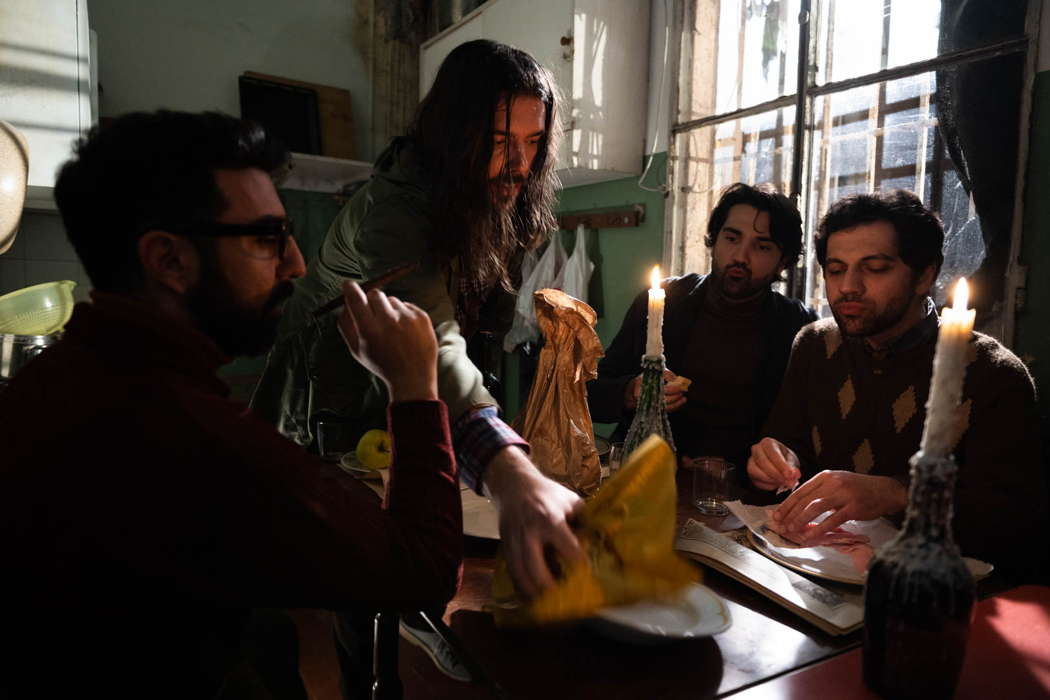
Davide Luciano as Marcello, Roberto Lorenzi as Schaunard, Jonathan Tetelman as Rodolfo and Giorgi Manoshvili as Colline in Teatro dell'Opera di Roma's La bohème. Photo © 2022 Fabrizio Sansoni
Still in the cast we find Armando Ariostini (Benoît), Bruno Lazzaretti (Alcindoro), Giordano Massaro (a street vendor), Vinicio Cecere (Parpignol), Daniele Massimi (a customs officer) and Alessandro Fabbri (customs officer). The chorus, protagonist of the second 'scene' (although in this version often 'off stage'), is prepared very well, as always, by Roberto Gabbiani.
The production is enriched by the costumes of Anna Biagiotti; Pasquale Mari signs the lighting and the direction of photography. Rai should schedule a rerun and, more importantly, make this Bohème available internationally.
Copyright © 9 April 2022
Giuseppe Pennisi,
Rome, Italy

MORE ARTICLES ABOUT 'LA BOHÈME'


